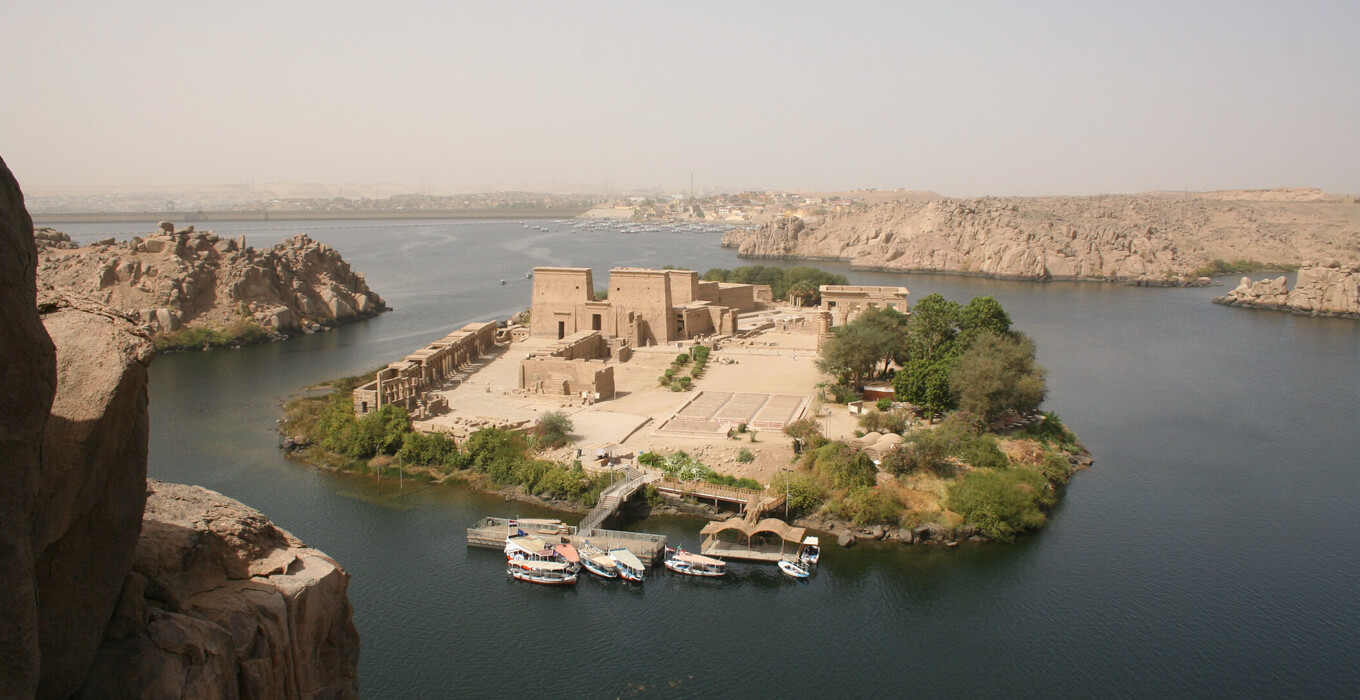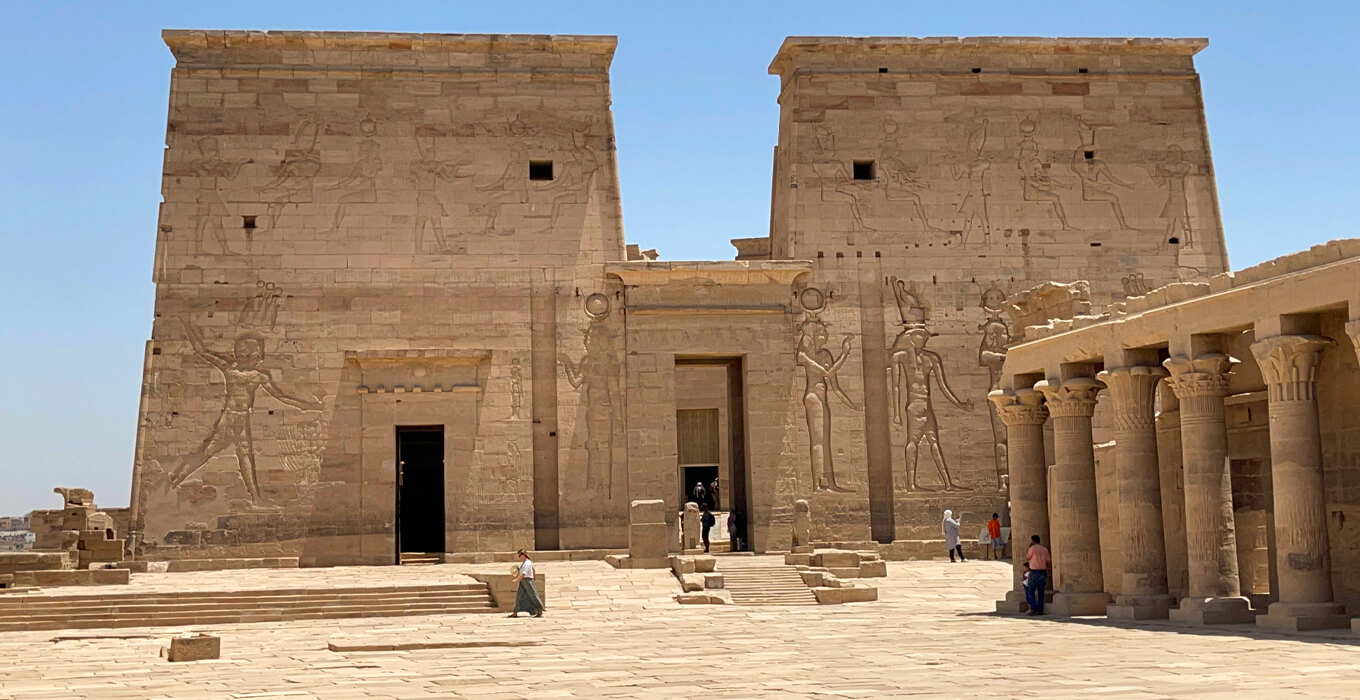The Temple of Philae complex is a stunning island temple in Egypt. It’s near the Aswan Low Dam, downstream of the Aswan Dam and Lake Nasser. Before the UNESCO Nubia Campaign, it was on Philae Island, by the First Cataract of the Nile in Upper Egypt.
This temple was moved to Agilkia Island as part of a global effort to save Nubian monuments. This was done before the Aswan High Dam was built. It helped keep the temple safe for future generations.
Key Takeaways
- Philae Temple is a UNESCO World Heritage Site located about 8 km south of Aswan, Egypt.
- The temple complex was originally situated on Philae Island, near the First Cataract of the Nile, but was relocated to Agilkia Island to protect it from the Aswan High Dam’s flooding.
- Philae Temple represents a mix of architectural styles and artistic traditions from various historical eras, including Ancient Egypt, the Ptolemaic Kingdom, the Roman Empire, and the spread of Christianity.
- The temple was dedicated to the goddess Isis and was a center of the cult of Isis, with daily priestly rituals and ceremonies occurring on the island.
- Philae Temple is renowned for its intricate carvings, hieroglyphics, and statues portraying Egyptian mythology, providing insights into the region’s rich cultural heritage.
Location and Geography of Philae Temple

The Philae Temple is in Aswan, Aswan Governorate, Egypt, in Nubia. Its coordinates are 24°1’15″N 32°53’22″E. It’s by the Nile River, after the Aswan Dam. Before, it was on Philae Island, near the First Cataract of the Nile.
Philae Island was about 380 meters long and 120 meters wide. It was close to Aswan, about 100 kilometers away. The temple has buildings from the Pharaonic era, Ptolemaic Kingdom, Roman, and Byzantine times.
Relocation to Agilkia Island
The Aswan High Dam made the temple move to Agilkia Island. This was to save it from the floodwaters. UNESCO’s Nubia Campaign worked hard to keep the area’s culture safe.
Now, the Philae Temple is a UNESCO World Heritage Site. It’s known for being part of “Nubian Monuments from Abu Simbel to Philae.” People from all over visit to see this ancient Egyptian wonder.
|
Location |
Coordinates |
Original Island |
Current Island |
Distance from Aswan |
|
Aswan, Egypt |
24°1’15″N 32°53’22″E |
Philae Island |
Agilkia Island |
Approximately 100 km |
History and Construction of Philae Temple
The Philae Temple in Aswan, Egypt, has a long and fascinating history. It started in the 7th or 6th century BC. The first temple was built by Pharaoh Taharqa, for the god Amun.
The Ptolemaic Kingdom (282-145 BC) made the temple even bigger and better. Ptolemy II Philadelphus and others built temples to please the Egyptians. This led to big changes and showed off the era’s skill in building.
Contributions from Pharaohs
Pharaohs like Psamtik II and Amasis II also helped the temple grow. They built things like a small kiosk for Isis. Nectanebo I, from the 30th Dynasty, also left his mark.
|
Pharaoh |
Dynasty |
Contribution |
|
Taharqa |
25th |
Built the first known shrine on the island, likely dedicated to Amun |
|
Psamtik II |
26th |
Constructed a small kiosk dedicated to the goddess Isis |
|
Amasis II |
26th |
Made contributions to the temple complex |
|
Nectanebo I |
30th |
Further expanded and enhanced the Philae Temple |
|
Ptolemy II Philadelphus |
Ptolemaic |
Oversaw major construction during the Ptolemaic Kingdom |
Ptolemy II Philadelphus and others from the Ptolemaic Kingdom greatly helped the temple. They wanted to meet the Egyptians’ religious needs and traditions.
Philae Temple in Aswan, Egypt – A Sacred Site
The Philae Temple in Aswan, Egypt, was a key spot for the Egyptians and Nubians. They saw it as a place where Osiris, the god of the underworld, was buried. This made it very special.
Only priests could live on the island, making it “the Unapproachable”. This rule made the temple even more sacred. It was a place to keep the secrets of Egyptian religion and myths safe.
Reverence by Egyptians and Nubians
Both Egyptians and Nubians saw the Philae Temple as very important. They thought it was where Osiris, the god of life after death, was buried. This made it a key spot for those who wanted to connect with the divine.
Exclusive Access for Priests
Only priests could live on Philae Island, making it “the Unapproachable”. This rule showed how special the temple was. It was a place where only a few could perform sacred rituals.
“Philae was held in high reverence both by the Egyptians to the north and the Nubians (often referred to as “Ethiopians” in Greek) to the south, as it was said to be one of the burying-places of Osiris. It was deemed profane for any but priests to dwell there and was accordingly sequestered and denominated “the Unapproachable”.”
The Cult of Isis and the Osiris Myth
Philae was a key place for the cult of Isis during the Saite period (664-525 BC). The Osiris myth was very important at these festivals. The story of Osiris’s death and coming back to life was acted out. Isis was key in finding and bringing her husband back to life.
Isis and the Osiris Myth
Isis played a big part in bringing Osiris back to life after he was killed by his brother Seth. Legends say Isis looked everywhere for Osiris’s body and was able to put it back together. This let Osiris come back to life and rule the underworld.
“Isis, the great, the divine mother goddess, who sought her brother/husband Osiris, who mourned him, who rejoiced when she found him, and who raised up the heir, Horus, to avenge his father and assume the kingship.”
Festivals and Rituals
Every year, the story of Osiris was acted out at festivals at Philae. People came from all over Egypt and Nubia for these events. They celebrated life, death, and being reborn, with Isis’s role in the Osiris story being very important.
- Rites dedicated to Isis and Osiris went on for about 500 years after Egypt was conquered by Rome in 30 B.C.
- Nubian kings paid for these festivals and helped support the temples for many years.
- The Isis cult lasted long after the pharaohs ruled, with festivals happening for centuries after 0 AD.
Philae was a very important place because of the cult of Isis and the Osiris myth. It was a key site in ancient Egypt and Nubia.
Relocation and Conservation Efforts
In the 1960s, the Philae Temple complex faced a big problem. The Nile River was rising because of the Aswan High Dam. To save the temple and other monuments, a big move was planned. This was part of the UNESCO Nubia Campaign.
From 1972 to 1980, the temple was taken apart stone by stone. Each stone was labeled and put back together on Agilkia Island. This big job moved not just the main Isis temple. It also moved smaller shrines that had been there for centuries.
The UNESCO Nubia Campaign started in 1960. It aimed to save over 20 ancient sites from being lost under Lake Nasser’s waters. The Philae Temple was a key part of this effort. Experts from all over the world worked together to save it.
Thanks to this big effort, the Philae Temple was saved from the flood. Now, people from all over can see its beauty, art, and history.
Philae Temple Relocation
- Dismantled and moved to Agilkia Island between 1972 and 1980
- Part of the UNESCO Nubia Campaign to save threatened archaeological sites
- Relocation involved meticulous cataloging and reassembly of each stone
UNESCO Nubia Campaign
- Launched in 1960 to save over 20 monuments from flooding due to Aswan High Dam
- Philae Temple was a centerpiece of the campaign, requiring a massive relocation effort
- Involved collaboration of experts from around the world to ensure preservation
The move and saving of the Philae Temple show the hard work and smart thinking of those involved. They worked hard to keep this ancient Egyptian treasure safe for the future.
Architectural Highlights and Decorations
The Philae Temple complex in Aswan, Egypt, is a sight to behold. It shows off ancient Egyptian architecture and religious art. The monuments on Philae and Agilkia Islands highlight Egyptian craftsmanship, even after the pharaohs were gone.
Impressive Reliefs Depicting Isis Mythology and Egyptian Deities
The temple walls have reliefs that tell the story of the goddess Isis and other Egyptian gods. These carvings show the legend of Osiris, a key figure in the Isis cult at Philae. They let visitors see the amazing art and detail of these old stories.
Remains of Roman, Byzantine, and Coptic Structures
The site also has parts from the Roman, Byzantine, and Coptic times. There are two Coptic churches among them. These show how important the site was for religion long after the pharaohs ruled. The mix of styles tells the story of Philae as a place where ancient cultures met.
|
Architectural Highlights |
Key Facts |
|
Impressive Reliefs |
– Depict Isis mythology and Egyptian deities – Showcase skilled ancient artistry – Preserve legendary tales of Osiris |
|
Remains of Roman, Byzantine, and Coptic Structures |
– Include two Coptic churches – Reflect Philae’s religious significance over centuries – Showcase the site’s diverse architectural heritage |
Philae Obelisk and the Decipherment of Hieroglyphs
The Philae Obelisk is 3.66 meters tall and weighs about 6 tons. It helped unlock ancient Egyptian hieroglyphs. Found in 1815 in the Isis Temple ruins on Philae Island, it has Greek and hieroglyphic inscriptions.
William John Bankes brought it to England in 1821. He saw the Philae Temple in Aswan, Egypt. Bankes saw the obelisk’s Greek inscriptions with Ptolemy V and Cleopatra’s names. This helped with deciphering hieroglyphs, along with the Rosetta Stone.
Now, the obelisk is in Kingston Lacy’s gardens in Dorset, England. But, it faced challenges. In 2014, it turned black with liverwort. This led to a project by the University of Oxford to show its inscriptions again.
|
Artifact |
Details |
|
Philae Obelisk |
|
The Philae Obelisk, along with the Rosetta Stone and other finds, still fascinates scholars and visitors. It connects us to ancient Egypt’s rich history and culture.
Significance in Literature and Culture
The Philae Temple in Aswan, Egypt, has always caught the eye of writers and artists. Its stunning ruins and deep history inspire many. They bring its importance to life through stories and poems.
Backdrop for Agatha Christie’s “Death on the Nile”
Agatha Christie’s famous book, “Death on the Nile,” is closely tied to the Philae Temple. The temple’s beauty was the perfect setting for her mystery story. It added depth and atmosphere to the tale.
“Ozymandias” by Percy Bysshe Shelley and Horace Smith
Poets have also been moved by the Philae Temple. Works like “Ozymandias” by Percy Bysshe Shelley and Horace Smith reflect on human achievements. They show how short-lived they can be, just like the ancient pharaohs.
“My name is Ozymandias, king of kings:
Look on my works, ye Mighty, and despair!”
– Percy Bysshe Shelley, “Ozymandias”
The Philae Temple’s role in literature and culture shows its deep impact. It stands as a symbol of ancient Egypt’s lasting legacy. Its beauty and history still move people all over the world.
Visiting the Philae Temple

The Philae Temple is a key spot for those wanting to see the Nile River in Aswan, Egypt. It’s easy to get to by boat down the Nile. This temple shows off the area’s deep culture and history.
Exploring the Philae Temple
To get to the Philae Temple, take a boat from Aswan Marina. This boat ride is about 10-15 minutes each way. The temple sits on Agilkia Island, moved here to save it from the dam’s floodwaters.
Getting into the Philae Temple is not too expensive. Adults pay about 50 EGP, and students get a discount. You can see amazing architecture, statues, and learn about its history.
Experiencing the Philae Temple’s Attractions
The temple has lots to do. You can see the Birth House, Kiosk of Trajan, and the Sanctuary of Isis. These spots show off the temple’s skill and its role in the Osiris myth. At sunset, the Philae Sound and Light Show lights up the temple with colors and stories.
The temple welcomes visitors from 7 a.m. to 4 p.m. (October to May) and 7 a.m. to 5 p.m. (June to September). It’s a great place to visit all year. With its history, beauty, and importance, the Philae Temple is a top spot in Aswan and on the Nile River cruise.
|
Attraction |
Description |
Admission Cost |
|
Philae Temple Complex |
Impressive temple dedicated to the goddess Isis, featuring remarkable architecture and reliefs |
50 EGP (adult), discounted rates for students |
|
Philae Sound and Light Show |
Captivating evening experience showcasing the temple illuminated with vibrant colors and audio commentary |
Included in temple admission |
|
Boat Taxi to Agilkia Island |
Scenic 10-15 minute boat ride from the Aswan Marina to the temple’s location |
Negotiable (approximately 50 EGP) |
Conclusion
The Philae Temple in Aswan, Egypt is a magical place that has drawn people from all over. It was a key spot for the Isis cult in the Ptolemaic Kingdom. It also helped unlock the secrets of hieroglyphs.
Thanks to careful preservation and being a UNESCO World Heritage Site, the temple still shows off Egypt’s ancient skills and faith. It sits by the Nile River, giving visitors a chance to dive into ancient Egyptian life.
Visitors can see detailed carvings of Isis stories, admire the mix of Greek and Egyptian designs, or feel the magic of the floodlit ruins. Going to the Philae Temple is a must for those wanting to explore Egypt’s history. With ongoing care and tours from experts like Luxor and Aswan Travel, it will keep amazing people for years to come.
Read our related articles:


